The Viking B-8 Kittyhawk was an American single-engine open-cockpit biplane of the early 1930s.
The Viking B-8 Kittyhawk was an American single-engine open-cockpit biplane of the early 1930s.
The Viking B-8 Kittyhawk was developed from the Bourdon B-4 Kittyhawk, 31 examples being built during 1930 and 1931 at Viking's factory in New Haven, Connecticut. Some aircraft were fitted with EDO floats for operation from water.
The Viking B-8 was flown by private pilot owners and by barnstorming firms who utilised the three-seat layout with a twin-passenger cockpit located ahead of separate pilot's cockpit.
In 2015 Viking Kitty Hawk Serial #28 was undergoing restoration to airworthiness following a landing accident in 1973.[ citation needed ] Viking Kitty Hawk Serial #30 is in storage at New England Air Museum. [1]
Data from [2]
General characteristics
Performance
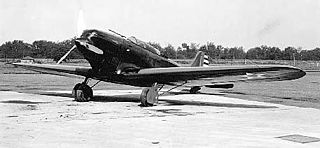
The Lockheed-Detroit YP-24 was a 1930s prototype two-seat fighter aircraft. An attack version called the A-9 was also proposed. The YP-24 is most remarkable for being the first fighter aircraft to bear the Lockheed name.
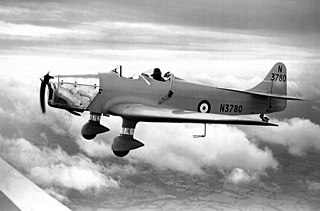
The Miles M.14 Magister is a British two-seat monoplane basic trainer aircraft built by the Miles Aircraft for the Royal Air Force and Fleet Air Arm. Affectionately known as the Maggie, the Magister was based on Miles' civilian Hawk Major and Hawk Trainer and was the first monoplane designed specifically as a trainer for the RAF. As a low-wing monoplane, it was an ideal introduction to the Spitfire and Hurricane for new pilots. Its sister design, the Miles Master was an advanced trainer also built by Phillips & Powis at Woodley.

The Miles M.11 Whitney Straight was a 1930s British two-seat cabin monoplane with dual-controls.

The Northrop C-19 Alpha was a series of three aircraft purchased from Northrop by the US Army Air Corps in 1931. They were slightly modified versions of the civil Northrop Alpha Type 2.

The Bensen B-8 is a small, single-seat autogyro developed in the United States in the 1950s. Although the original manufacturer stopped production in 1987, plans for homebuilders are still available as of 2019. Its design was a refinement of the Bensen B-7, and like that aircraft, the B-8 was initially built as an unpowered rotor-kite. It first flew in this form in 1955, and on 6 December a powered version, designated B-8M first flew. The design proved to be extremely popular and long-lasting, with thousands of sets of plans sold over the next thirty years.
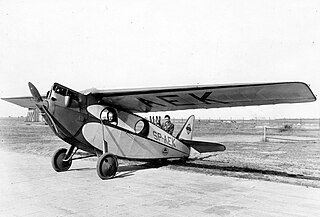
The RWD 4 was a Polish sports plane of 1930, constructed by the RWD team.

The Junkers A50 was a German sports plane of the 1930s, also called the A50 Junior.

The Boeing Model 200 Monomail was an American mail plane of the early 1930s.

The Evans VP-2 is a development of the Evans VP-1 Volksplane, both of which were designed in La Jolla, California by aeronautical engineer William Samuel "Bud" Evans. Evans had formerly worked at Convair, Ryan Aircraft and General Dynamics.

The Boeing B-1 was a small biplane flying boat designed by William Boeing shortly after World War I.

The Pitcairn Mailwing family was a series of American mail carrier and three-seat sport utility biplane aircraft produced from 1927 to 1931.

The Seibel S-4 was a two-bladed, single-engine helicopter built by Seibel Helicopter. Designed by Charles Seibel, the S-4 was evaluated by the United States Army under the designation YH-24 Sky Hawk, but would be rejected for service. The S-4B would serve as the basis for the design of the Cessna CH-1 Skyhook, the only helicopter Cessna ever produced.

The Arrow Sport was a two-seat sporting biplane aircraft built in the United States in the 1920s and 1930s.

The Arrow Model F or the Arrow Sport V-8 was a two-seat low-wing braced monoplane aircraft built in the United States between 1934 and 1938. It was built originally to a request by the US Bureau of Air Commerce to investigate the feasibility of using automobile engines to power aircraft. Accordingly, the Model F was fitted with a modified Ford V8 engine. Like the Arrow Sport before it, the Model F seated its pilot and passenger side-by-side in an open cockpit and was marketed for $1500.

The Buhl LA-1 Bull Pup was a light sports airplane developed in the United States in 1930. It was a mid-wing wire-braced monoplane with fixed tailskid undercarriage and an open cockpit for the pilot. Buhl developed the Bull Pup as a cheap aircraft through which the company hoped to remain in business as the onset of the Great Depression was felt. However, as the economic situation worsened, it became evident that there was no demand for even such a basic aircraft; when production ceased in 1932, all aircraft still in stock were sold off at half price as the company folded.
The Supermarine Commercial Amphibian was a British passenger-carrying flying boat designed by Reginald Mitchell and built by the Supermarine Aviation Works.

The International F-18 Air Coach was a 1920s American biplane transport that was designed and manufactured by the International Aircraft Corporation in Long Beach, California. The company stopped manufacturing F-18's by 1928 and sold its rights to the aircraft in 1931.
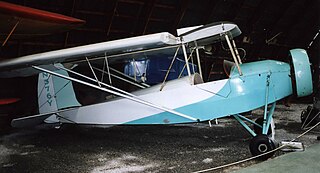
The Nicolas-Beazley NB-8G is a United States two-seat parasol wing light monoplane that was constructed in the early 1930s.

The Alliance A-1 Argo was an American-built two-seat biplane of the late 1920s.
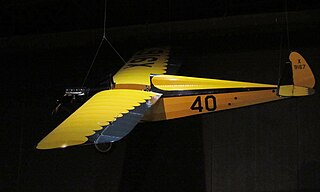
The Church Midwing JC-1, a.k.a. Church Mid-Wing Sport, is a midwing racing aircraft designed by James Church using the fuselage of a Heath aircraft.
| Wikimedia Commons has media related to Viking B-8 Kittyhawk . |